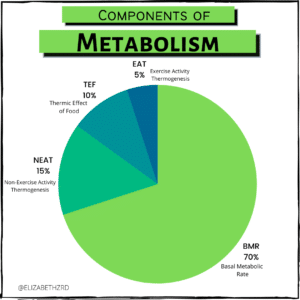A Close Look at Metabolism
November 17, 2021
You’ve probably heard of phrases such as, “Boost your metabolism.” But what does this mean?
Metabolic rate feels like one of those buzz phrases with a vague definition that people like to throw around.
Metabolism is the process by which your body converts what you eat and drink into energy. Your body’s metabolic rate (or total energy/calorie expenditure) can be divided into several components, which are: BMR, NEAT, EAT, and TEF.
Below, we’ll go over the unique components that make up our total metabolic rate and what we can do to impact some of them.
Let’s get into it…
Basal Metabolic Rate (BMR)
Basal metabolic rate refers to the number of calories your body burns at rest each day. Meaning, even if you lie in bed all day and don’t consume a single calorie, your body will still burn a certain number of calories to carry out its many processes, such as breathing, eating, repairing cells and circulation.
BMR varies between individuals. Some aspects that play a role in BMR variation are: genetics, body composition, body size, gender, age and hormones.
Body composition: The more muscle on your body, and the less fat, the higher your metabolic rate. This is due to the fact that muscle uses more energy than fat while at rest. Men typically have more muscle than women, so typically have a higher metabolic rate (not fair for us women!).
Age: As we age, we lose muscle, causing a slow down in metabolism. This happens more so after age 60, according to a recent study.
Gender: Women generally have a lower BMR than males, largely due to lower muscle mass.
Hormones: Thyroid hormone is a key regulator of BMR. T3 and T4 have a significant role in metabolism. T3 and T4 are released into the blood stream from the thyroid gland and are transported throughout the body where they control metabolism. These hormones work throughout the body to tell the body’s cells how much energy to use.
Body size: The larger your body, the higher the BMR. Larger people usually have a faster BMR to accommodate for extra weight and for their body to work harder to perform normal body functions.
For Example:
150 lb person male might have a BMR of 1580 calories
165 lb male might have a BMR of 1730 calories
Genetics: Just as every other aspect of our body, genetics plays a role in metabolism.
In general, research suggests that BMR can account for as much as 70 percent of our daily energy expenditure.
Non-Exercise Activity Thermogenesis (NEAT)
Next to BMR, non-exercise activity thermogenesis is the next component that accounts for a significant percentage of our caloric expenditure. As its name suggests, NEAT accounts for all of the calories we burn outside our dedicated exercise time.
Getting out of bed, brushing your teeth, walking to school or work, playing with your kids, fidgeting, waiting in line for your morning coffee, and virtually every other activity you do contributes to NEAT. NEAT contributes to a substantial number of calories burned each day.
According to research, NEAT can vary by as many as 2,000 calories between individuals of similar size. That is a huge number! NEAT is a component of our TDEE that we can vary to a considerable degree. So, just moving more through out the day can have a large impact on your daily calorie burn.
Exercise Activity Thermogenesis (EAT)
Unlike NEAT, exercise activity thermogenesis only accounts for the number of calories we burn from dedicated exercise. EAT also includes the calories we burn after the exercise session is finished – this is known as the excess post-exercise oxygen consumption (EPOC). However, physical activity accounts for only a small part of your total energy burned — about 5 percent, unless you’re a professional athlete. As you can see with these numbers, we can’t work off a poor diet!
Thermic Effect of Food (TEF)
As we consume a meal, the body expends a specific number of calories to break it down and absorb the nutrients. This depends on the meal’s size and composition. In general, digesting food (or TEF) accounts for about 10 percent of the calories we burn each day.
Each of the three macronutrients has a specific thermic effect (TE). Protein has a TE of 15 to 30 percent, carbs have a TE of about 5 to 10 percent, and fats have a TE of 0 to 3 percent. For example, if you eat 100 calories worth of protein, your body will expend 15 to 30 calories to break it down and absorb it.
Total Daily Energy Expenditure (TDEE)
Total daily energy expenditure is the combination of our BMR, EAT, NEAT, and TEF. Because of that, our TDEE tends to vary from day to day, even if slightly.
Is my slow metabolism the reason why I can’t lose weight?
Probably not! Many people blame a slow metabolism for weight gain or inability to lose weight. However, a slow metabolism is usually not the main driver of being overweight or obese. Excess weight is the result of a combination of aspects such as genetics, diet, hormones, behaviors, medications, physical activity and other factors. However, the largest role in the prevalence of obesity in Western society is our access to highly palatable, energy dense food and sedentary lifestyles. Simply put: We are eating too much and not moving enough !
So, instead of blaming your metabolism for difficulty losing weight, put your focus on factors that are more likely affecting your progress. Take a close and honest look at your diet and lifestyle habits and evaluate how you can improve. The good news is that there are likely changes you can make to your diet and lifestyle to help control your weight.
How to Boost Your Metabolic Rate: 5 Effective Tactics
There is no magic food that will speed up your metabolism significantly, despite what you might have heard. These 5 tips may help when incorporated consistently :
1. Boost Your NEAT
Given that NEAT accounts for the biggest percentage of our TDEE after BMR, we should actively work on keeping it high. So, an excellent way to boost your metabolic rate is to boost your NEAT. According to studies, keeping our NEAT high over time can have a big impact on our weight management. In addition to dedicated exercise time (EAT), we should strive to be more active in our day-to-day life. The bottom line is move more! Here are some ideas you can incorporate:
-Walk to run errands, when possible
-Take the stairs more often
-Get up regularly during your work day to get in some movement. Stand up regularly and walk around
-Use a standing desk
-Play with your kids
-Park your car further in a parking lot
Increasing your NEAT is probably the easiest and most effective way to boost your metabolic rate.
2. Consume More Protein
As we discussed above, protein is the nutrient with the highest thermic effect. A good way to boost your TDEE without changing much about your life is to increase your protein intake. Also, getting adequate protein during weight loss, can help to combat muscle losses (along with weight training). Good sources of protein include fish, meat, poultry, tofu, beans, lentils, cottage cheese, and eggs. Be sure to include a protein source at each meal while still balancing out your meals with other important macro nutrients such as healthy carbohydrates and fats.
3. Get Adequate Sleep
Sleep is vital for our health, well-being, and energy levels. It impacts almost every system within the body and can boost or destroy productivity. Also, given that research finds a strong correlation between sleep and various metabolic functions, we must get enough of it. Studies show that a lack of sleep can reduce your metabolism.
According to most guidelines, we should aim for seven to nine hours of sleep per night.
4. Build muscle
Since muscle burns more calories than fat, then changing your body composition would help boost your metabolism, according to studies. Your basal metabolic rate is directly correlated with the amount of muscle you have. The metabolic boost from strength training is not massive, but significant enough that it’s worth incorporating as a strategy. Also, resistance training (along with adequate protein) may also help you retain muscle and counteract the drop in metabolism that can occur during weight loss and aging. In addition, there are numerous benefits to weight training that go beyond metabolism : greater mobility, strength, flexibility, heart health, blood glucose control, mood etc.
With all the benefits of strength training, it’s definitely worth including it into your workout routine.
5. Add HIIT (High intensity interval training) to your work out regime
HIIT is very intense bursts of exercise (80-95% of person’s maximum heart rate) alternating with short rest periods or low intensity exercise. The intense work periods may range from 5 seconds to a few minutes.
Research has shown that HIIT workouts can boost your metabolic rate hours after exercise is done.
Understanding the science of metabolism does give us some perspective on the matter. However, most importantly, loosing weight and weight maintenance all boil down to healthy lifestyle habits such as diet, exercise, daily movement, and sleep that are consistent over time.




Great article! Do you have a source for the effect of muscle on metabolic change? I’ve read different values- anywhere from 5-10 calorie increase per pound of muscle.
Thanks Samantha :)Metabolism is quite a fascinating topic ! This article from University of New Mexico is frequently used a a resource and gives a great explanation of how many calories extra muscle burns.
https://www.unm.edu/~lkravitz/Article%20folder/metabolismcontroversy.html